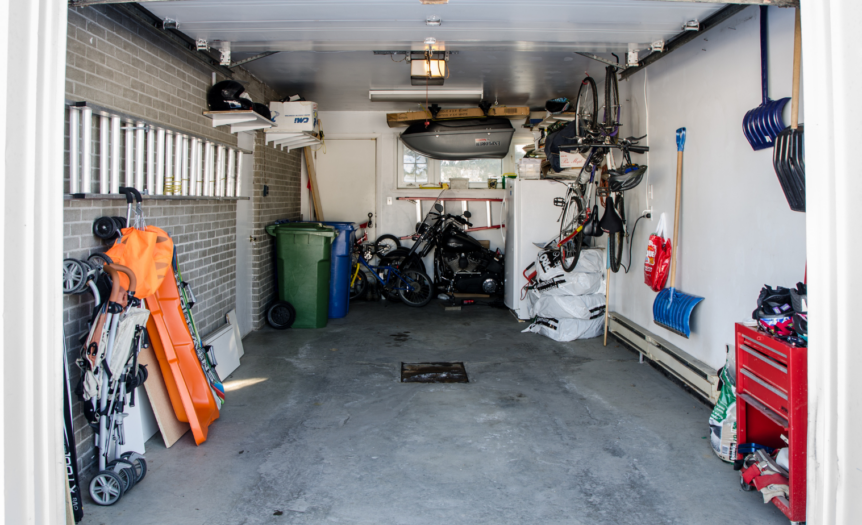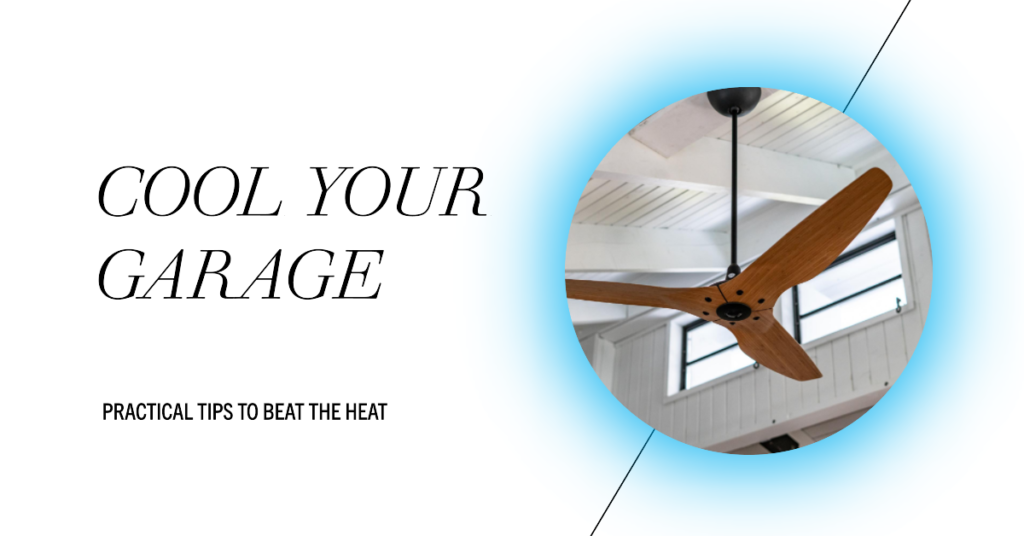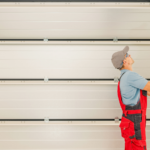As the summer heat intensifies, you might find yourself wondering how to cool your garage and create a comfortable space for working on projects or storing your belongings.
Keeping your garage at a pleasant temperature not only ensures a comfortable work environment but also protects your valuable items and keeps equipment functioning properly.
These are the various methods – from insulation and ventilation to air conditioning solutions – that can help transform your sweltering garage into an oasis of cool relief.
Key Takeaways
- Cooling your garage is important for a comfortable work environment, protecting your belongings from damage due to high temperatures, and ensuring that equipment functions properly by preventing overheating.
- The best ways to cool a garage include insulating walls and ceiling, installing air conditioning or swamp coolers, improving ventilation, using fans and air circulation, and choosing the right paint color.
- If you cannot install an AC unit in your garage, portable fans/electric fans or dehumidifiers are great options for cooling down the area. Additionally, insulation/sealing leaks and using window film/shades can help reduce heat gain.
- Regular maintenance of ceiling fans is essential for efficient use of energy while providing refreshing breezes throughout the space.
Why You Need To Cool Your Garage
Cooling your garage is important for a comfortable work environment during hot summer months, protecting your belongings from damage due to high temperatures, and ensuring that equipment functions properly by preventing overheating.
Comfortable Work Environment
A comfortable work environment in your garage is essential for both productivity and overall enjoyment. As temperatures rise during the summer months, an excessively hot garage can become unbearable, causing fatigue and discomfort.
One example of how cooling a garage can positively impact your work experience comes from a woodworking enthusiast who was able to complete his custom furniture projects more efficiently after installing insulation and proper ventilation systems in his garage space.
By maintaining a cooler temperature, he found himself spending more time working on his craft without feeling overheated or exhausted.
Protecting Your Belongings
Keeping your belongings safe and in good condition is an essential reason why you need to cool your garage. Extreme temperatures can damage or destroy items like electronics, power tools, paint cans, bicycles, and other equipment that may be stored in the garage.
Cooling your garage helps to maintain optimal conditions for storing your belongings. By regulating the temperature with proper insulation or air conditioning units, you’ll avoid costly repairs or replacements due to heat-related damages.
Additionally, sealing any air leaks will keep dust and pests out of your storage spaces so that they remain clean and organized.
Keeping Equipment Functioning Properly
A garage is not only a place to park your car, but it’s also an area where you keep equipment and tools. When the temperature in the garage gets too high, it can lead to damage or malfunctioning of sensitive equipment.
For instance, if you keep electrical equipment in the garage, exposure to high temperatures can cause them to overheat and break down easily.
To avoid such scenarios, it’s crucial to keep your garage cool by using insulation and proper ventilation systems. These options help regulate temperature levels inside the room and prevent any adverse effects on your valuable items’ functionality.
Additionally, consider storing any heat-sensitive items closer to air conditioning vents or fans for added protection against extreme temperatures.
Best Ways To Cool A Garage
Insulating walls and ceiling, installing air conditioning, improving ventilation, using fans and air circulation, and choosing the right paint color are among the best ways to cool a garage.
Insulating Walls And Ceiling
One of the most permanent ways to cool down a garage is by insulating its walls and ceiling. This can be done by adding insulation materials between the studs in wall cavities or using foam board insulation for the ceiling.
Insulation helps to prevent heat from entering through walls and roof, keeping the garage cool even in hot weather.
For example, an R-value of 13-15 is recommended for garages located in warmer regions while 19-21 could be ideal for colder areas. By adding proper insulation as per regional requirements, you can create a comfortable work environment and protect your equipment during summer months when temperatures rise drastically.
Installing Air Conditioning
One of the most effective long-term solutions for cooling a garage is to install an air conditioning unit. This will not only keep the garage cool during summers but also prevent moisture buildup throughout the year, which can lead to mold growth and other damages.
To ensure maximum cooling efficiency, it is important to choose an appropriately sized air conditioner based on the size of your garage. For instance, a 10,000 BTU AC unit should be enough for a typical one-car garage.
Whether opting for window-mounted or portable units, there are several options available that cater specifically to garages’ needs such as high-powered fans with adjustable settings and energy-efficient models that are designed specifically for use in poorly ventilated spaces like garages.
Improving Ventilation
One of the most effective ways to cool down a garage is by improving ventilation. Proper ventilation can help to remove hot air and allow cool air to circulate within the space.
Exhaust fans can be installed on the ceiling or walls of a garage and are designed to pull hot air out of the space. Vents can also be added to improve airflow into and out of the garage.
Increasing ventilation not only helps cool down a hot garage but also improves indoor air quality by reducing moisture buildup that promotes mold growth.
Fans And Air Circulation
Fans are an effective way to cool down a garage as they help to circulate the air, moving hot air out and allowing cooler air in. Ceiling fans or portable fans can be used for this purpose.
Another option is installing an exhaust fan or vent in the roof or walls of your garage, which helps to remove heat and moisture from inside. This also helps to reduce odors and fumes that may accumulate within the garage.
Additionally, keeping doors and windows open during cooler times of day allows for good ventilation which ensures proper circulation of air within the garage.
Choosing The Right Paint Color
Picking the right color for your garage can make a significant difference in its temperature. Dark colors typically absorb more heat, leading to warmer temperatures inside the garage.
On the other hand, light-colored paint reflects sunlight and heat, making it an ideal option for cooling down a garage.
Another option is to use reflective paint designed specifically for garages. This type of coating uses reflective particles that bounce back sunlight and infrared radiation, resulting in cooler temperatures inside your garage.
Plus, it’s often easy to apply yourself with just a roller or sprayer.
Cooling A Garage Without AC
There are several options available for cooling a garage without an air conditioner, including portable fans, swamp coolers, and dehumidifiers.
Portable Fans And Electric Fans
Portable fans and electric fans are a great option for cooling down your garage. They come in different sizes, designs, and power levels to suit your needs. You can use a floor fan or mount an industrial ceiling fan to increase air circulation within the garage.
One important thing to keep in mind when using portable or electric fans is that they don’t cool down the temperature of the air itself but instead help to circulate cooler air throughout space.
Therefore, it’s best to pair this solution with others like insulation or ventilation for maximum effect.
Swamp Coolers
Swamp coolers, also known as evaporative coolers, can be an effective way to keep your garage cool without using an air conditioner. These units work by pulling in hot air and passing it through a wet filter or pad, which cools the air as water evaporates.
The cooled air is then circulated back into the garage. Swamp coolers are affordable and easy to install, making them a popular choice for homeowners looking for budget-friendly options.
While swamp coolers can help to significantly lower temperatures inside your garage, they do have some limitations. They may not be as effective in areas with high humidity levels since water evaporation is slowed down by moisture in the air.
Additionally, they require regular maintenance like cleaning and replacing filters to prevent mold growth that could negatively impact indoor air quality.
Dehumidifiers
Dehumidifiers are a great option for cooling down a garage without ventilation. Garages tend to accumulate moisture, which can make it difficult to work in hot weather. Dehumidifiers help to remove the excess moisture from the air and make it feel cooler inside the garage.
It’s important to choose the right size dehumidifier based on the square footage of your garage.
In addition to cooling down your garage, using a dehumidifier also helps protect your belongings from damage caused by excessive humidity. For example, tools and equipment can rust or corrode when exposed to high levels of humidity over time.
Portable Air Conditioning Units
Portable air conditioning units are a great option for cooling down your garage without having to install permanent fixtures. These units can be easily moved around the space, making them ideal for temporary use during the hottest months.
They come in different sizes and cooling capacities, so you’ll want to choose one that is appropriate for the size of your garage.
Portable air conditioners work by taking in warm air from the room and passing it through a refrigerated coil to extract heat and moisture, which is then expelled outside.
Some models also come with an exhaust hose that needs to be vented through a window or door. While portable ACs may not be as efficient as central air conditioning systems, they offer flexibility in terms of usage and affordability.
Insulation And Sealing Air Leaks
Insulating the walls and sealing air leaks in your garage is a permanent solution for cooling it down. This process involves adding insulation to the walls or ceiling of your garage, which helps prevent outside heat from entering while also keeping cool air inside.
Sealing all air leaks, including around windows and doors, prevents hot outdoor air from infiltrating the space.
Moreover, proper insulation can help lower energy bills as it reduces the need for artificial cooling methods such as fans or ACs that consume more electricity. Insulation comes in various materials like fiberglass batts, rigid foam boards, spray-on foam that fills gaps between framing studs or joists where traditional forms do not fit correctly.
Additional Tips For Cooling A Garage
Using shade and window film can help to reduce the amount of sunlight entering the garage, which can help keep it cooler during hot summer months.
Using Shade And Window Film
One of the easiest and most cost-effective ways to cool a garage is by using shade and window film. This can be achieved by installing shades or curtains on the windows, which will help prevent direct sunlight from entering your garage during hot summer days.
Alternatively, you could use reflective window films that bounce back heat from the sun and keeps the inside cooler.
Another option is to create shade outside of your garage using planted vegetation or other structures like gazebos or awnings.
By reducing solar radiation into your garage, you’ll ultimately reduce internal temperatures, minimizing energy consumption from air conditioners or fans.
Ceiling Fans And Proper Maintenance
Ceiling fans are an effective and affordable way to cool down a garage. They work by increasing air circulation, which can help to keep the space comfortable even in the scorching heat of summer.
To make sure they work properly, it’s important to maintain them regularly.
Proper maintenance not only ensures that your ceiling fan will last longer but also helps it run more efficiently. This means it will use less energy while still providing a refreshing breeze throughout your garage.
Additionally, consider running your ceiling fan counterclockwise during summertime as this direction pushes cooler air downwards towards you in contrast with clockwise rotation during winter months that draws warm air up towards the ceiling.
Installing Insulated Garage Doors
Garage doors are typically made of metal, which can absorb heat and contribute to a hotter interior. One solution is to install insulated garage doors that can help regulate the temperature inside the space.
Insulated garage doors also provide benefits beyond just cooling down a hot garage. They can improve energy efficiency by reducing air leaks and limiting thermal transfer, helping to lower your utility bills.
Additionally, they offer improved noise reduction and added security for your belongings stored in the garage.
Safety Considerations
It’s crucial to consider safety when cooling down your garage. Before implementing any of the strategies discussed, ensure that you are not compromising on safety in any way.
For example, if you’re using portable fans or air conditioning units with electrical cords, make sure they are placed out of high-traffic areas and away from water sources.
When insulating your garage walls or ceiling, be mindful of potential hazards such as materials handling and cutting tools like saws and knives.
Finally, avoid blocking windows or doors where natural ventilation can occur as it might pose a fire hazard during times of extreme heat waves.
By keeping these safety considerations in mind while cooling down your garage, you can enjoy a comfortable workspace without compromising on anyone’s wellbeing!
Conclusion
Cooling a garage in the summer months is crucial to maintaining a comfortable workspace and protecting your equipment. Whether you choose permanent solutions like insulation, ventilation or air conditioning or portable options like fans, swamp coolers, and dehumidifiers, keeping your garage cool is essential.
Remember to also consider shade solutions, window film, ceiling fans and insulated garage doors as additional ways to keep temperatures down.
FAQs:
1. What are some effective methods for cooling a garage?
Some effective methods for cooling a garage include installing insulation, using ceiling fans or portable fans, adding ventilation such as windows or vents, and utilizing air conditioning units specifically designed for garages.
2. Can I use a regular air conditioning unit to cool my garage?
It is possible to use a regular air conditioning unit to cool your garage but not all units may be suitable depending on the size and layout of your space. It’s best to consult with an HVAC professional who can recommend the appropriate unit for your specific needs.
3. How can I improve airflow in my garage without adding windows or vents?
One way to improve airflow in your garage without adding windows or vents is by installing an exhaust fan that circulates hot air out of the space while pulling cooler air in from outside.
4. Are there any energy-efficient options available for cooling a garage?
Yes, there are several energy-efficient options available for cooling a garage including evaporative coolers which work by drawing in warm dry air and passing it through moistened pads resulting in cooler, humidified air being circulated into the space. Another option is mini-split systems which use minimal amounts of electricity to provide targeted cooling where needed within larger areas like garages without relying on ductwork making them more efficient overall.
Related Posts
How to get rid of flies in garage
How to get rid of mice in garage
How to lubricate a garage door
How to heat a garage
How to clean garage floor
How much to epoxy garage floor
How to paint garage door
Why do garage doors open by themselves









